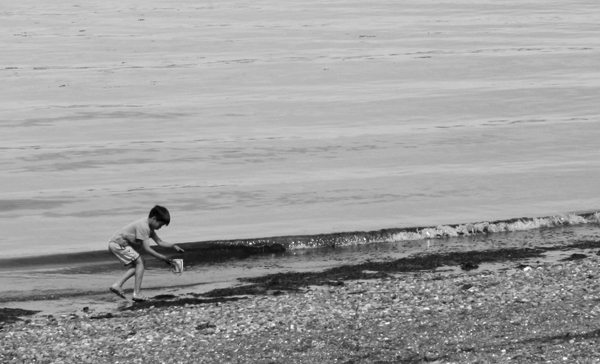For those who wait all year for regular dips in the chilly Puget Sound waters, the health of local beaches is boding well when compared to a national picture of more contamination, beach closures and advisory days.
The Natural Resources Defense Council (NRDC) recently published its annual report on the country’s beaches, and ranked the state of Washington 14th out of 30 in beach water quality.
Though the state fared decently in the NRDC report, it has local and state agencies worried about the context in which citizens will understand the data.
“The more you monitor, the more problems you are going to find,” said Jim Zimny, environmental specialist at the Kitsap County Health District. “I can say soundly that the water is getting cleaner. But Kitsap County is sampling more beaches than anywhere else in the state, so we are going to have more contamination listings than anywhere else. We are focusing on the dirty water to clean it up, so we stop sampling the cleaner water because we aren’t going to waste our resources.”
Only two of the island’s beaches were monitored last year. 88 percent of the 51 samples taken at Eagle Harbor’s Waterfront Park were below the state’s bacteria limit in 2010. 98 percent of the 45 samples taken at Fay Bainbridge park tested below bacteria limits, according to the report.
This year, the district was granted more beach monitoring funds than ever before, and thus added several new beaches to monitor – including where the end of Lytle Road intersects with Pleasant Beach on the south end of the island.
In places like Louisiana, which had the highest rate of reported contamination with 37 percent of samples above bacterial limits, the causes obviously can be traced to the BP oil spill disaster. In New Hampshire, it was reported that only 1 percent of beach samples were contaminated.
Pomeroy Park–Manchester Beach in Kitsap County had one of the highest bacteria sample rates in the state at 19 percent. Silverdale County Park came in at 13 percent. Sewage spills were the main cause of high-bacteria closures in Washington.
Zimny said that the county has to be careful about how the data is used. Since the county is turning up more contamination in its testing, he said the district has to work to ensure that data isn’t misconstrued. In one case last year, the county actually lost beach monitoring funding due to political pressure since the data illustrated a growing problem, he said.
The state also responded to the advocacy reports issuing a press release saying that the most “accurate, reliable and timely” information about state beaches can be found on its website and through the BEACH (Beach Environmental Assessment, Communication and Health) program.
Julie Lowe, who manages the joint Department of Ecology and Department of Health BEACH program, said she was pleased with how well local beaches scored on the NRDC report. She said that only 6 percent of all the beach samples taken during 2010 for the state were above bacteria level limits. But since the data is a year old, she said it doesn’t provide a very timely picture of the situation.
“So far this year Bainbridge beaches are doing well,” said Lowe. “All testing results remain low and we haven’t had any problems resulting in beach closures or restrictions on swimming.”
The Kitsap Count Health District is the agency that makes the decision to post or close a beach, while the state program supports the local agencies using federal funds from the Environmental Protection Agency (EPA).
This year BEACH is monitoring about 70 of the state’s most popular saltwater beaches, which is up from 52 beaches in 2010 thanks to an increase in EPA funding.
Monitoring begins after Memorial Day and goes until Labor Day. Zimny tests the waters of Fay Bainbridge, Eagle Harbor at Waterfront Park and Lytle Road End Park once a week – along with numerous other beaches in the county.
Last week one of the three samples Zimny took from Fay Bainbridge came up with bacteria levels that would qualify for a beach closure. The other two samples, however, came up clean. As per county procedure, Zimny returned the following day for a follow-up, which also came up clean.
“Without a pollution source across the entire beach and only one spot with high numbers it doesn’t make sense to close the beach,” he said. “The amount of water that moves across Fay Bainbridge beach is unfathomable (because of the currents) so if there is true pollution we will continue to pick it up at numerous places on the beach.”
Last year over the Fourth of July weekend, a soiled diaper was found floating in the Eagle Harbor waters, which resulted in a beach closure.
“Every little thing like throwing one dirty diaper can elevate bacteria enough to the point that we have to close the beach,” said Lowe. “The simple things people can do, like not leaving litter, keeping the dog on a leash and making sure to clean up after the dog, will make a big difference,” he said.
With only three Bainbridge beaches monitored and 53 miles of island shoreline, there are plenty of places where bacteria can go undetected. But with limited resources and funding, the county uses a risk analysis method to determine the most popular beaches with close proximity to contamination sources to determine which beaches are tested and monitored.
Keeping Bainbridge beaches clean, Zimny said, is the responsibility of everyone who uses them.
The state’s BEACH program has a new coastal atlas on its website, which can be used to search for real-time beach closures throughout the state: https://fortress.wa.gov/ecy/coastalatlas/
A BEACH Facebook, Twitter and blog also provide instant updates on beach health, advisories and closures.


